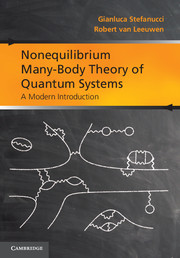Book contents
- Frontmatter
- Contents
- Preface
- List of abbreviations and acronyms
- Fundamental constants and basic relations
- 1 Second quantization
- 2 Getting familiar with second quantization: model Hamiltonians
- 3 Time-dependent problems and equations of motion
- 4 The contour idea
- 5 Many-particle Green's functions
- 6 One-particle Green's function
- 7 Mean field approximations
- 8 Conserving approximations: two-particle Green's function
- 9 Conserving approximations: self-energy
- 10 MBPT for the Green's function
- 11 MBPT and variational principles for the grand potential
- 12 MBPT for the two-particle Green's function
- 13 Applications of MBPT to equilibrium problems
- 14 Linear response theory: preliminaries
- 15 Linear response theory: many-body formulation
- 16 Applications of MBPT to nonequilibrium problems
- Appendices
- References
- Index
8 - Conserving approximations: two-particle Green's function
Published online by Cambridge University Press: 05 March 2013
- Frontmatter
- Contents
- Preface
- List of abbreviations and acronyms
- Fundamental constants and basic relations
- 1 Second quantization
- 2 Getting familiar with second quantization: model Hamiltonians
- 3 Time-dependent problems and equations of motion
- 4 The contour idea
- 5 Many-particle Green's functions
- 6 One-particle Green's function
- 7 Mean field approximations
- 8 Conserving approximations: two-particle Green's function
- 9 Conserving approximations: self-energy
- 10 MBPT for the Green's function
- 11 MBPT and variational principles for the grand potential
- 12 MBPT for the two-particle Green's function
- 13 Applications of MBPT to equilibrium problems
- 14 Linear response theory: preliminaries
- 15 Linear response theory: many-body formulation
- 16 Applications of MBPT to nonequilibrium problems
- Appendices
- References
- Index
Summary
Introduction
In this and the next two chapters we lay down the basis to go beyond the Hartree–Fock approximation. We develop a powerful approximation method with two main distinctive features. The first feature is that the approximations are conserving. A major difficulty in the theory of nonequilibrium processes consists in generating approximate Green's functions yielding a particle density n(x, t) and a current density J(x, t) which satisfy the continuity equation, or a total momentum P(t) and a Lorentz force F(t) which is the time-derivative of P(t), or a total energy E(t) and a total power which is the time-derivative of E(t), etc. All these fundamental relations express the conservation of some physical quantity. In equilibrium the current is zero and hence the density is conserved, i.e., it is the same at all times; the force is zero and hence the momentum is conserved; the power fed into the system is zero and hence the energy is conserved, etc. The second important feature is that every approximation has a clear physical interpretation. In Chapter 7 we showed that the two-particle Green's function in the Hartree and Hartree–Fock approximation can be represented diagrammatically as in Fig. 7.1 and Fig. 7.2 respectively. In these diagrams two particles propagate from (1′, 2′) to (1, 2) as if there was no interaction.
- Type
- Chapter
- Information
- Nonequilibrium Many-Body Theory of Quantum SystemsA Modern Introduction, pp. 235 - 248Publisher: Cambridge University PressPrint publication year: 2013



